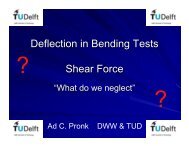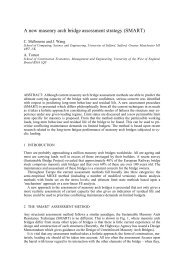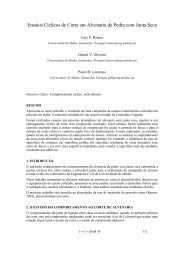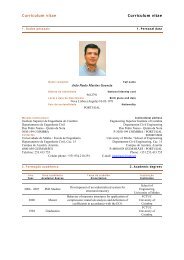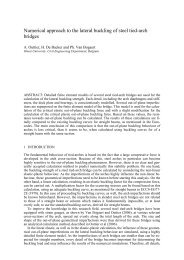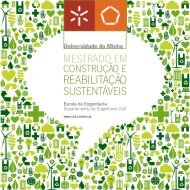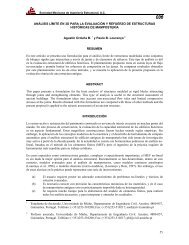SipdECO â Development of innovative solutions for eco- efficient ...
SipdECO â Development of innovative solutions for eco- efficient ...
SipdECO â Development of innovative solutions for eco- efficient ...
Create successful ePaper yourself
Turn your PDF publications into a flip-book with our unique Google optimized e-Paper software.
<strong>SipdECO</strong> – <strong>Development</strong> <strong>of</strong> <strong>innovative</strong> <strong>solutions</strong> <strong>for</strong> <strong>eco</strong><strong>efficient</strong><br />
partition walls<br />
(Proj.nº 3419)<br />
Financing Institution(s):<br />
SI Innovation and Technological <strong>Development</strong>, I&DT Projects enterprises<br />
in co-promotion (Funding ADI)<br />
Promoting Institution(s): S<strong>of</strong>alca - Soc. Central de Produtos de Cortiça, Lda<br />
Coordinator(s): Graça Vasconcelos (University <strong>of</strong> Minho)<br />
Researchers and collaborators: Graça Vasconcelos; Paulo B. Lourenço; Pedro Medeiros; Aires Camões,<br />
Paulo Mendonça, Paulo Carvalho, Said Jalali, Rute Eires, Ricardo Mateus,<br />
Manuela Almeida, Luís Bragança, Sandra Cunha, César Cardoso, Elisa<br />
Poletti<br />
Partner Institutions: S<strong>of</strong>alca - Soc. Central de Produtos de Cortiça, Lda; Biosafe S.A.;<br />
Pegop - Energia Eléctrica, S.A.<br />
Period: January 2009 -<br />
Relevant facilities:<br />
Diverse day-to-day laboratory equipment, cell test <strong>for</strong> the evaluation <strong>of</strong> thermal and<br />
acoustic behaviour <strong>of</strong> partition and enclosure walls<br />
Objectives:<br />
There are many by-products created in industry that can be r<strong>eco</strong>vered or valued <strong>for</strong> the creation <strong>of</strong> new products<br />
allowing, in this way, the decrease <strong>of</strong> environmental damages caused by its disposal in landfills and contribute to a<br />
more sustainable construction. Thus, the main aim <strong>of</strong> the project is to propose an <strong>innovative</strong> <strong>eco</strong>-<strong>efficient</strong> solution<br />
<strong>for</strong> partitions walls by valuing <strong>of</strong> several industrial by-products; (a) flue gas desulfurization (FGD) gypsum from<br />
exhaust gases <strong>of</strong> thermoelectric power plants; (b) granulate cork from insulation black cork boards and (c) textile<br />
fibres from the recycling <strong>of</strong> used tyres. Besides the study <strong>of</strong> the material by achieving the optimized composition<br />
by mixing distinct percentages <strong>of</strong> the raw materials, the design <strong>of</strong> the composite block and the technology <strong>of</strong><br />
construction <strong>of</strong> the partitions walls should be pointed out. The main issue to be solved is the placing <strong>of</strong> electrical<br />
and hydraulic installations without making grooves after construction <strong>of</strong> the walls, reducing the waste and<br />
contributing also <strong>for</strong> the construction sustainability. In spite <strong>of</strong> partitions walls are not structural, it is intended to<br />
validate the mechanical behavior under compression, to impact loads and to eccentric compression and comparison<br />
the per<strong>for</strong>mance with traditional <strong>solutions</strong>. Additionally, the results <strong>of</strong> the evaluation <strong>of</strong> the thermal and the<br />
acoustic behavior should be provided. Finally, the evaluation <strong>of</strong> the sustainability <strong>of</strong> the solution is to be evaluated.<br />
Main achievements:<br />
The composite material results from the<br />
combination <strong>of</strong> FGD gypsum, re-granulated<br />
expanded cork, textile fibers and the setting time<br />
retarder, the citric acid. The FGD gypsum is a<br />
synthetic industrial by-product which comes from<br />
flue gas desulfurization <strong>of</strong> thermal power plants. It<br />
is chemically identical to conventional gypsum,<br />
provides more environmentally friendly applications<br />
and is highly available. Cork (part <strong>of</strong> Quercus Suber<br />
L) is a material whose characteristics are <strong>of</strong> great<br />
interest <strong>for</strong> the construction industry. It is regarded<br />
as a strategic material <strong>of</strong> great potential due to its<br />
reduced density, elasticity, compressibility,<br />
resistance to water, good vibration absorption and a<br />
good efficiency in thermal and acoustic isolation.<br />
Moreover, textile fibers obtained by recycling <strong>of</strong><br />
used tires were also used in order to confer a<br />
greater resistance and ductility to the composite<br />
material. Four distinct compositions were analyzed,<br />
namely a pressed composition composed only <strong>of</strong><br />
FGD gypsum and three moulded compositions (M)<br />
resulting from the combination <strong>of</strong> FGD gypsum,<br />
textile fibers and cork, by varying the percentage <strong>of</strong><br />
cork 5, 7 and 9% mass <strong>of</strong> gypsum.<br />
A new block has been developed <strong>for</strong> the execution<br />
<strong>of</strong> partition walls in new buildings, as well as in the<br />
rehabilitation <strong>of</strong> walls in existing buildings. The<br />
block consists <strong>of</strong> the assemblage <strong>of</strong> two symmetric<br />
halves. The block was designed so that vertical and<br />
horizontal holes are achieved.<br />
The block has an external and rectangular part with a<br />
constant thickness <strong>of</strong> 25mm and an internal part with<br />
variable thickness, constituted <strong>of</strong> concave and convex<br />
shapes. In the concave parts, the block has a thickness<br />
<strong>of</strong> 70mm and in the convex presents a thickness <strong>of</strong><br />
about 25mm. The connection between blocks is made<br />
through a male-female system both in bed and head<br />
joints. It is intended that the vertical joints acts as dry<br />
masonry joints and a thin layer <strong>of</strong> gypsum mortar is<br />
added at the bed joints. The major advantage <strong>of</strong> the<br />
block consists <strong>of</strong> the possibility <strong>of</strong> installation the<br />
infrastructures without the need <strong>of</strong> making holes after<br />
construction <strong>of</strong> the wall, avoiding the waste <strong>of</strong> materials<br />
and reduction <strong>of</strong> the cross section. For this, it is<br />
intended that the construction <strong>of</strong> the walls is phased<br />
according to the following steps: (1) the laying <strong>of</strong> half<br />
block up to a certain level in height; (2) installation <strong>of</strong><br />
infrastructures and (3) connection <strong>of</strong> the other half<br />
block. The assemblage <strong>of</strong> the two half blocks is made<br />
through the perimeter <strong>of</strong> the inner face and the<br />
concave zones with appropriate adhesive material. The<br />
uniaxial compressive tests in full scale specimens and<br />
impact tests on full scale walls are under preparation.<br />
The validation <strong>of</strong> the compressive behaviour has been<br />
carried out based on small specimens following the<br />
standard respecting the characterization <strong>of</strong> masonry<br />
and close values to the traditional systems has been<br />
found. The cell test designed to assess the thermal and<br />
acoustic per<strong>for</strong>mance has been calibrated on a<br />
traditional solution.<br />
19
Fig. 1 Shape <strong>of</strong> the composite block <strong>for</strong> partition walls<br />
Fig. 7 Results <strong>of</strong> the experimental tests; (a) <strong>for</strong>cedisplacement<br />
diagrams; (b) cracking pattern<br />
Fig. 2 Details <strong>of</strong> the constructive system<br />
Fig. 7 Construction <strong>of</strong> specimen to uniaxial compression tests<br />
on high size specimens<br />
Relevant publications:<br />
Camões, A., Cardoso, C., Cunha, S., Vasconcelos, G.,<br />
Medeiros, P., Eires, R., Jalali, S., Lourenço, P.,<br />
Caracterização de materiais compósitos è base de FGD,<br />
8º Congresso Nacional de Mecânica Experimental,<br />
Universidade do Minho, 21-23 de Abril, em CDRom,<br />
2010.<br />
Fig. 3 Manufacture process and automatic mould<br />
Camões, A. Cardoso, C. Eires, R., Cunha, S.,<br />
Vasconcelos, G., Medeiros, P., Jalali, S., Lourenço, P.B.,<br />
FGD gypsum based composite <strong>for</strong> non-structural<br />
application in construction, Portugal SB10, Sustainable<br />
Building – Af<strong>for</strong>dable to All, Low Cost Sustainable<br />
Solutions, 185-192, 16-18 March, 2010, Faro, Portugal.<br />
G. Vasconcelos, E. Poletti, , P. Medeiros, P. Mendonça,<br />
P. Carvalho. S. Cunha, A. Camões, P.B. Lourenço,<br />
Innovative solution <strong>for</strong> partition walls, XXXVII IAHS<br />
World Congress on Housing, October 26 – 29,<br />
Santander, Spain, paper 178, in CDRom, 2010.<br />
Contacts:<br />
Graça Vasconcelos<br />
Tel.: +351 253 510 200<br />
Fax: +351 253 510 217<br />
Email: pbl@civil.uminho.pt<br />
URL:www.civil.uminho.pt/masonry<br />
Fig. 4 Details <strong>of</strong> experimental testing on compressive tests<br />
<strong>of</strong> blocks<br />
Fig. 5 Numerical simulation <strong>of</strong> composite blocks under<br />
compression<br />
20



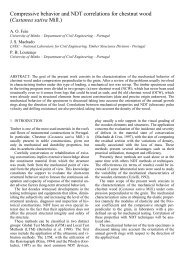
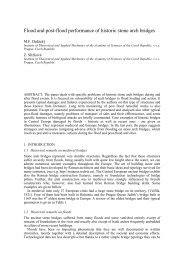
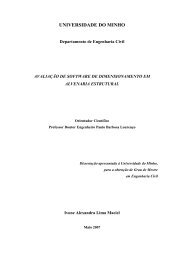
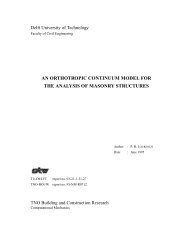

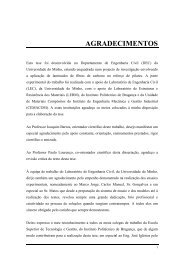

![Weibull [Compatibility Mode]](https://img.yumpu.com/48296360/1/190x134/weibull-compatibility-mode.jpg?quality=85)
